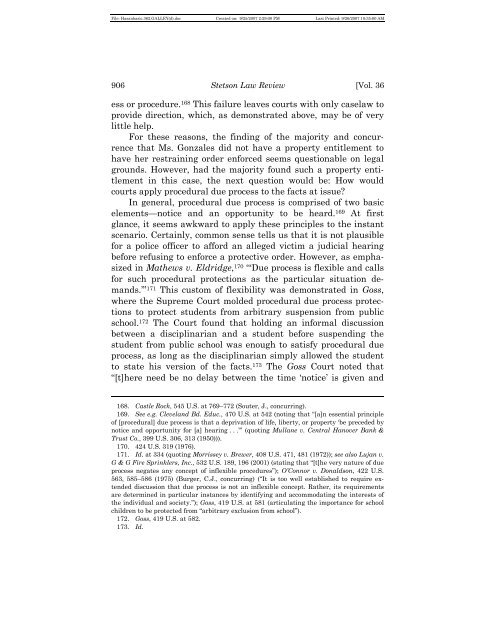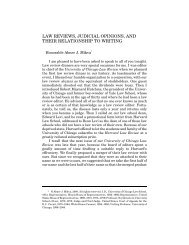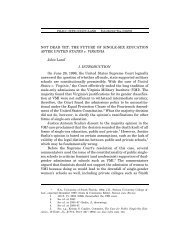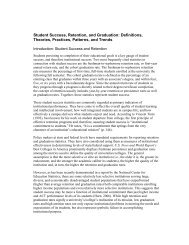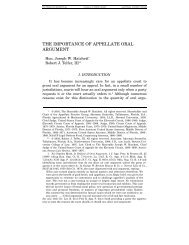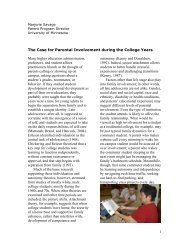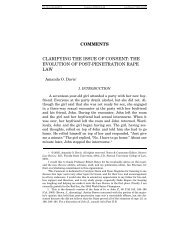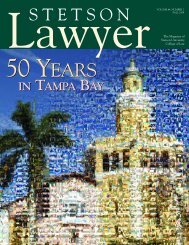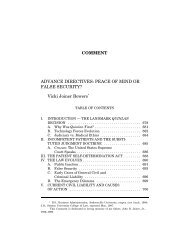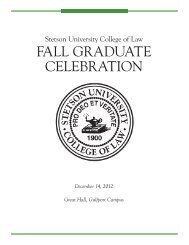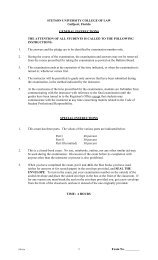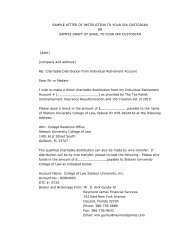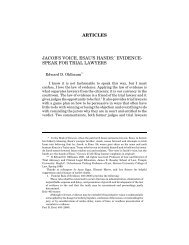TOWN OF CASTLE ROCK v. GONZALES: THE ... - Stetson University
TOWN OF CASTLE ROCK v. GONZALES: THE ... - Stetson University
TOWN OF CASTLE ROCK v. GONZALES: THE ... - Stetson University
You also want an ePaper? Increase the reach of your titles
YUMPU automatically turns print PDFs into web optimized ePapers that Google loves.
File: Hasanbasic.362.GALLEY(d).doc Created on: 9/25/2007 2:29:00 PM Last Printed: 9/26/2007 10:35:00 AM906 <strong>Stetson</strong> Law Review [Vol. 36ess or procedure. 168 This failure leaves courts with only caselaw toprovide direction, which, as demonstrated above, may be of verylittle help.For these reasons, the finding of the majority and concurrencethat Ms. Gonzales did not have a property entitlement tohave her restraining order enforced seems questionable on legalgrounds. However, had the majority found such a property entitlementin this case, the next question would be: How wouldcourts apply procedural due process to the facts at issue?In general, procedural due process is comprised of two basicelements—notice and an opportunity to be heard. 169 At firstglance, it seems awkward to apply these principles to the instantscenario. Certainly, common sense tells us that it is not plausiblefor a police officer to afford an alleged victim a judicial hearingbefore refusing to enforce a protective order. However, as emphasizedin Mathews v. Eldridge, 170 “‘Due process is flexible and callsfor such procedural protections as the particular situation demands.’”171 This custom of flexibility was demonstrated in Goss,where the Supreme Court molded procedural due process protectionsto protect students from arbitrary suspension from publicschool. 172 The Court found that holding an informal discussionbetween a disciplinarian and a student before suspending thestudent from public school was enough to satisfy procedural dueprocess, as long as the disciplinarian simply allowed the studentto state his version of the facts. 173 The Goss Court noted that“[t]here need be no delay between the time ‘notice’ is given and168. Castle Rock, 545 U.S. at 769–772 (Souter, J., concurring).169. See e.g. Cleveland Bd. Educ., 470 U.S. at 542 (noting that “[a]n essential principleof [procedural] due process is that a deprivation of life, liberty, or property ‘be preceded bynotice and opportunity for [a] hearing . . .’” (quoting Mullane v. Central Hanover Bank &Trust Co., 399 U.S. 306, 313 (1950))).170. 424 U.S. 319 (1976).171. Id. at 334 (quoting Morrissey v. Brewer, 408 U.S. 471, 481 (1972)); see also Lujan v.G & G Fire Sprinklers, Inc., 532 U.S. 189, 196 (2001) (stating that “[t]he very nature of dueprocess negates any concept of inflexible procedures”); O’Connor v. Donaldson, 422 U.S.563, 585–586 (1975) (Burger, C.J., concurring) (“It is too well established to require extendeddiscussion that due process is not an inflexible concept. Rather, its requirementsare determined in particular instances by identifying and accommodating the interests ofthe individual and society.”); Goss, 419 U.S. at 581 (articulating the importance for schoolchildren to be protected from “arbitrary exclusion from school”).172. Goss, 419 U.S. at 582.173. Id.


